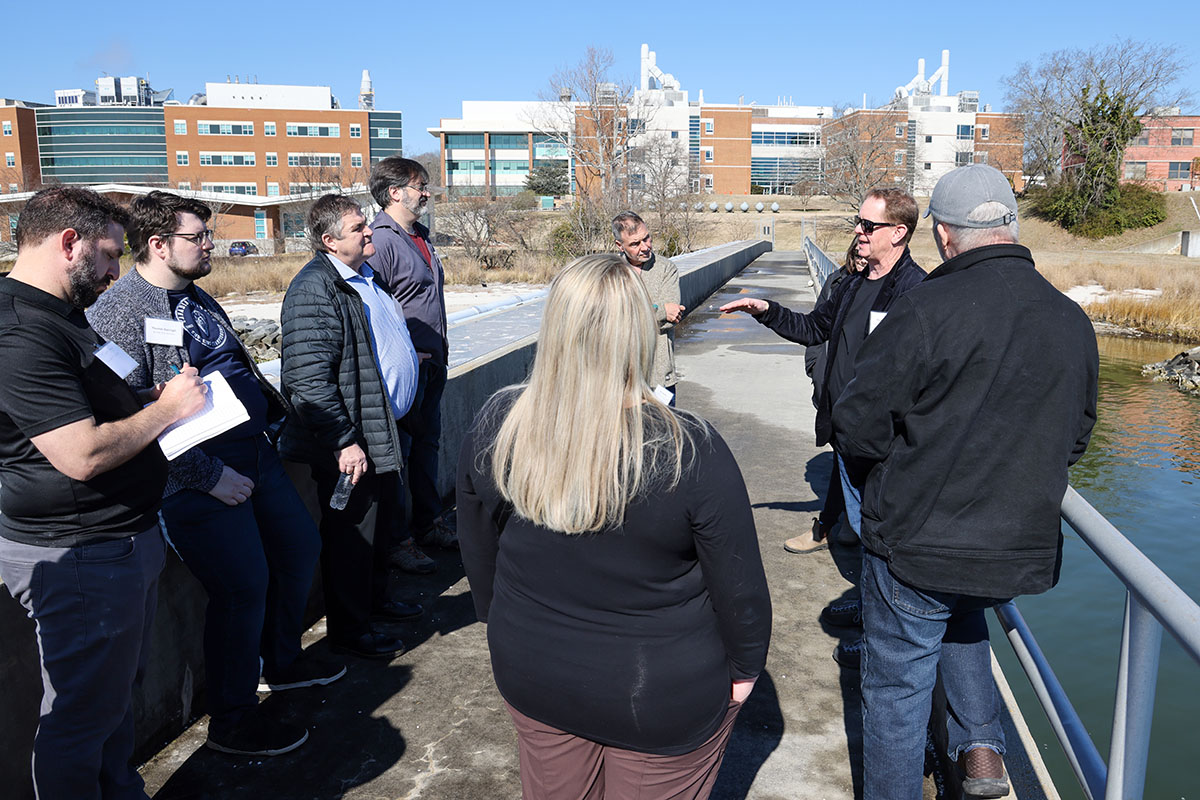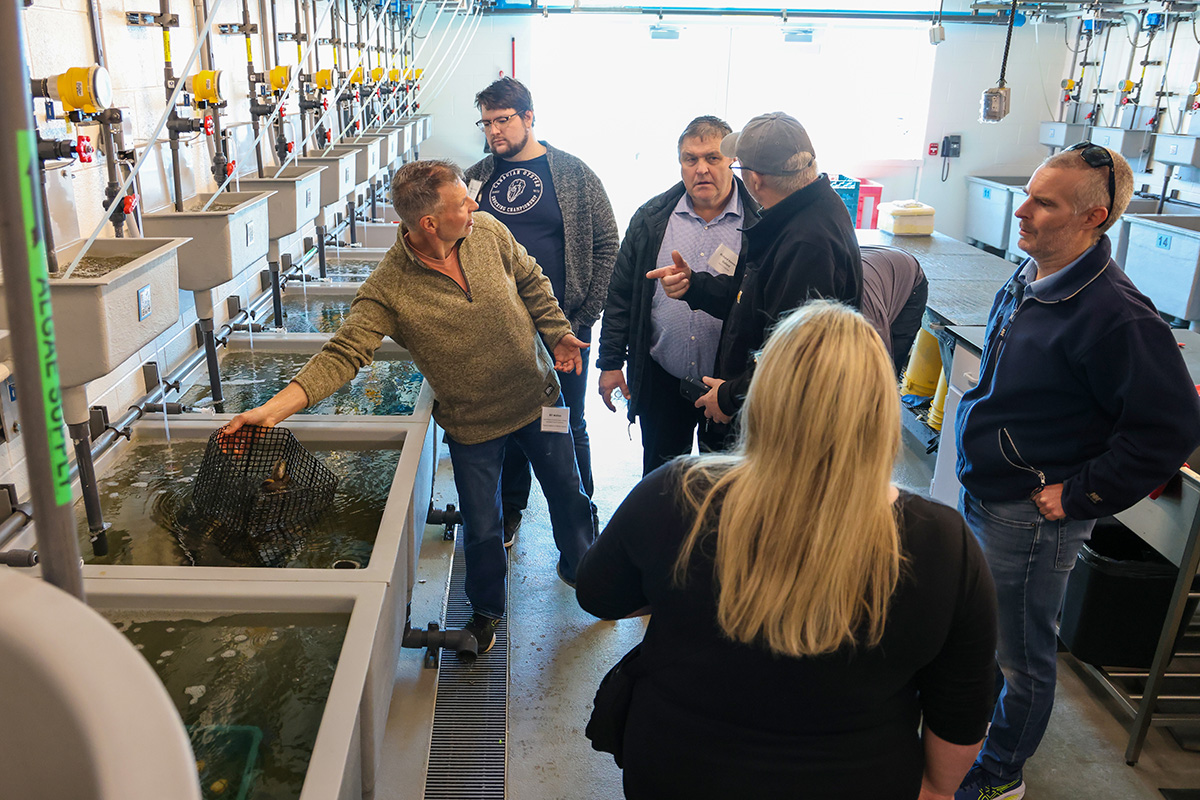Virginia’s experience with MSX aids Atlantic Canada’s aquaculture industry

William & Mary’s Batten School & VIMS recently hosted a delegation of government officials and aquaculture industry representatives from Atlantic Canada. Alarmed by the discovery of the oyster disease MSX (Multinucleate Sphere X) in the waters around Prince Edward Island (PEI) last July, they came to learn more about the strategies Virginia has employed to manage this serious shellfish disease.
MSX had already been discovered around Nova Scotia in 2002, leading to significant mortality. Batten School of Coastal & Marine Sciences & VIMS Professor Ryan Carnegie worked closely with government officials and the local industry during the initial response, making his expertise highly sought-after when the disease emerged in PEI. Additionally, Assistant Professor Jessica Small provided her expertise in genetics and breeding for resistance to MSX as well as another disease called dermo, caused by the parasite Perkinsus marinus. In the months following, they participated in workshops, answered queries from privately owned businesses and even appeared in Canadian news coverage of the crisis.
In late 2024, the PEI Aquaculture Alliance, which represents the island's oyster industry, requested to tour the Batten School & VIMS. Small coordinated the visit, which grew to include government officials, fishery managers, scientists and other industry stakeholders. Working with her colleagues in the Shellfish Aquaculture Program, Small developed an agenda that included time with experts at the Batten School & VIMS as well as representatives from regional industry.
“PEI is the largest producer of oysters in Eastern Canada. It’s a $24 million industry and we have a small population, so it’s quite stressful thinking about the potential impact,” said Kim Gill, director of aquaculture for Prince Edward Island. “We’ve formed close relationships with Drs. Ryan Carnegie and Jessica Small. They have a very unique and community-based approach to research and collaboration with all components of the industry, so we were keen to learn more and perhaps replicate some of it on a smaller scale back home.”
The delegation from Atlantic Canada spent their first day touring the Batten School & VIMS Gloucester Point campus and participating in focused discussions with researchers, students and staff. They were also able to speak with officials from the Virginia Marine Resources Commission and visit a local aquaculture farm. Industry visits continued the following day with additional tours of hatchery, nursery, farm and processing operations. Part of the group remained for a third day, visiting the Eastern Shore Lab in Wachapreague, VA, and touring privately owned aquaculture operations in the area.
Virginia’s strategy for oyster survival
In the U.S., MSX was first discovered in Delaware Bay in 1957. In just a few years, it spread throughout the Chesapeake Bay where it killed 90-95% of infected oysters.
“In the late 1990s, Virginia’s oyster industry collapsed due to MSX, dermo and overharvesting. The strategies we implemented in response gave rise to our intensive aquaculture industry and the restoration of wild oysters,” said Carnegie, who directs the Shellfish Pathology Laboratory at the Batten School & VIMS. “The hope is that PEI will be able to move through this just as successfully as we did, and hopefully faster because they can learn from our experience and have better tools and approaches.”
Virginia considered multiple responses, including introducing a non-native oyster species. Ultimately, the state opted to pursue a combination of innovative fishery management, habitat restoration and selective breeding. The Batten School & VIMS was instrumental in these efforts, particularly in providing pathology services to support management of diseases and the breeding of disease-resistant oysters for both aquaculture and the restoration of wild populations. As part of the response, the Aquaculture Genetics and Breeding Technology Center (ABC) was established in 1997 with a primary focus on the development of disease-resistant oyster broodstock.
Charting a path for PEI
 Much of the advice provided to the Canadian workgroup centered on supporting their wild oyster populations while moving as quickly as possible to hatchery production of disease-resistant oyster seed in support of the aquaculture industry. Additional discussions involved fishery management practices, collaborations with local and regional industry and disease testing and surveillance.
Much of the advice provided to the Canadian workgroup centered on supporting their wild oyster populations while moving as quickly as possible to hatchery production of disease-resistant oyster seed in support of the aquaculture industry. Additional discussions involved fishery management practices, collaborations with local and regional industry and disease testing and surveillance.
“We were very interested in seeing the labs, hatchery and diving into details about the breeding program. Our next steps are planning, monitoring and disease surveillance, so the timing of this trip and the relationships we’ve formed are really helpful,” said Gill. “I want to stress that we’re very thankful for everything that everyone at VIMS has done in the past 6-7 months. I’ve had lots of sleepless nights, but just being able to reach out to people who have gone through this or are going through this is very helpful.”
Overall, the collaboration showed the importance of knowledge sharing and the willingness of those in the shellfish aquaculture industry to help one another. By leveraging Virginia’s hard-earned lessons, there is hope that PEI can navigate the challenges of MSX to protect its vital oysters.
